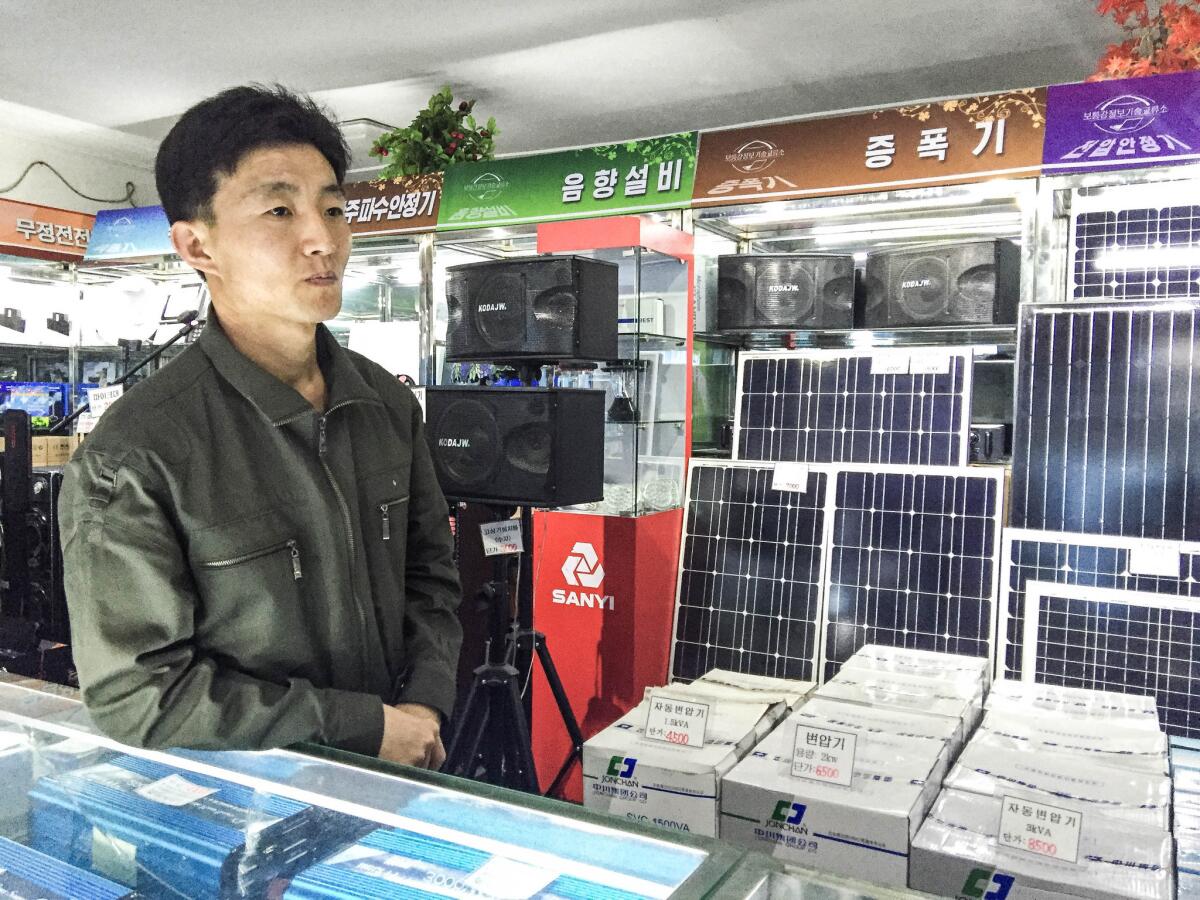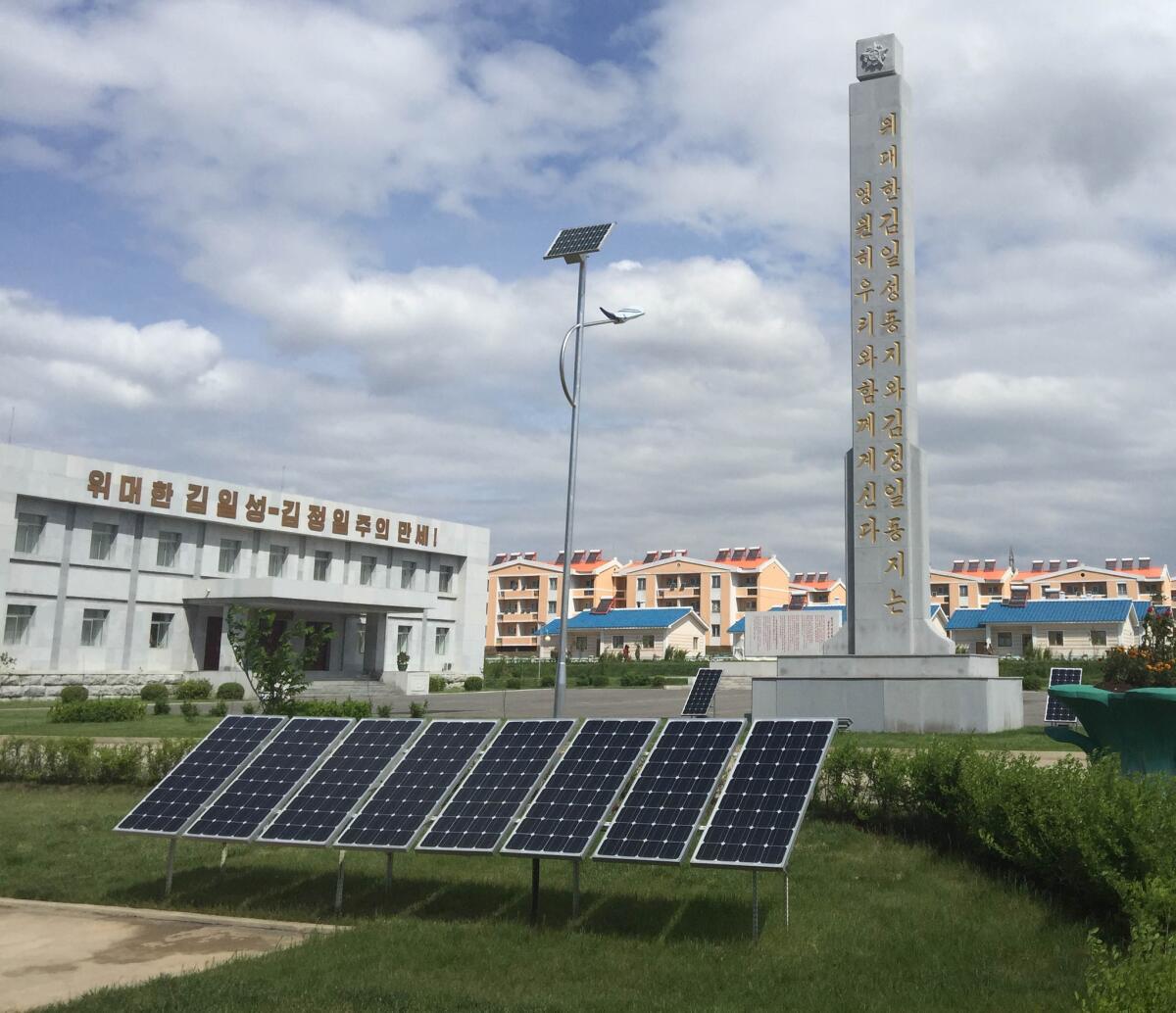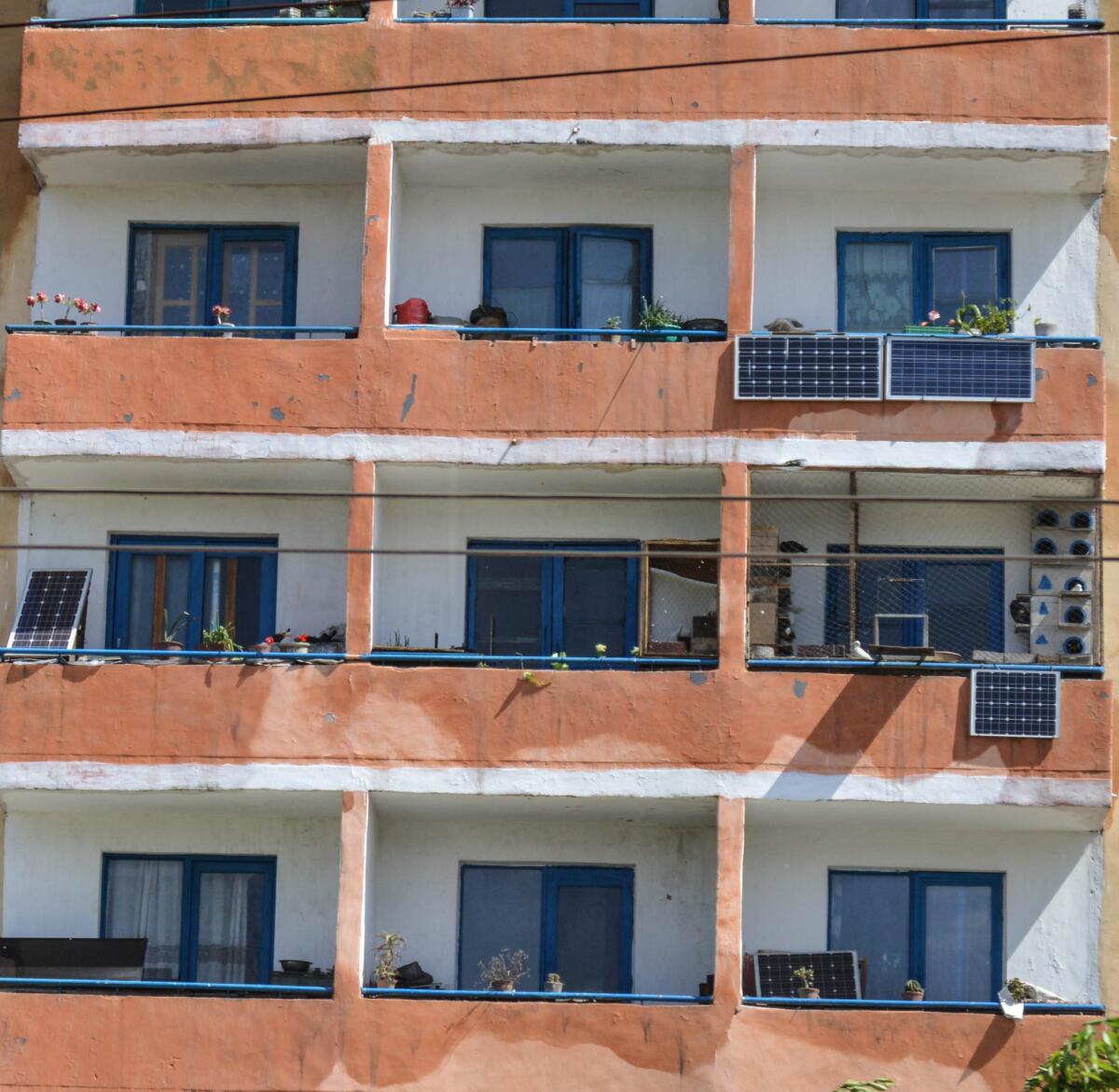Off the (failing) grid in North Korea, where solar energy is a hot commodity

- Share via
Think of it as a North Korean Best Buy — a shop stuffed with refrigerators, karaoke machines, laptop computers and flat-screen TVs. But with a square footage closer to a typical American 7-Eleven than a big-box store, the Pothonggang Information Technology Center has to be selective about what products it puts on its shelves.
So it’s telling that nearly one whole wall of the shop was crammed last week with solar panels, inverters and battery packs designed to store up the sun’s energy. The cheapest panel, a 50-watt Chinese import, was selling for about $35 at the official exchange rate — about a typical month’s wage for a factory worker — while a 200-watt, 24-volt version was going for about $160.
“We’re selling about 150 panels a month,” said the clerk, who had never before seen a foreign reporter walk into his shop and declined to give his name. “Our government has made using natural energy a priority, so from last year we’ve been selling them quite actively. At first, it was individual families, but now factories and offices are buying them too.”
Beset by crippling power shortages for decades, North Koreans are turning to solar power in a major way. With cheap panels readily available in neighboring China, a gray market expanding in North Korea, and a green-energy drive endorsed by supreme leader Kim Jong Un, there’s been a remarkable flowering of photovoltaic panels across the insular country.
Though North Korea has not published any figures, the panels can be seen on the balconies of nearly every apartment building in the capital, Pyongyang, and many streetlights are powered by the sun. Larger arrays, along with solar water heaters, have been affixed to industrial sites such as the Kim Jong Suk Pyongyang Silk Factory and the Jangchon collective farm on the southeastern outskirts of the capital. A large solar field was installed last fall on Pyongyang’s Ssuk Island near a new showcase complex called the Sci-tech Center, a sort of exploratorium/library/research hub, which also boasts of having geothermal technology.

To be sure, solar power is nowhere near being a cure-all for North Korea’s overall energy needs; hydropower and coal-fired plants are the overtaxed workhorses of the socialist state’s crumbling grid. David Von Hippel, a researcher with the Nautilus Institute in Berkeley who has been studying the country’s power infrastructure since the 1990s, estimates solar accounted for just 0.1% of all electricity generated in the country in 2015.
Nevertheless, solar is having an outsized effect on ordinary people’s lives. “It may be a small amount of electricity but it’s used for things that really matter a lot,” he says. “You can’t use it very well to run a factory or light a whole office building, at least with the number and size of solar panels they’re using. But if it gives you access to charging your phone or using your computer or DVD player or having some lights at night, it’s a great thing.”
An analysis based on Chinese customs data and other information by Von Hippel and another researcher, Peter Hayes, estimates that 100,000 or more North Korean households in the country of 24 million had acquired solar panels through the end of 2014. Von Hippel says the country has imported roughly 15 megawatts of photovoltaic systems through last year -- a third of that in 2015 alone.
If it gives you access to charging your phone or using your computer or DVD player or having some lights at night, it’s a great thing.
— David Von Hippel, a researcher with the Nautilus Institute in Berkeley
“Probably more North Koreans have electricity now than they have since the 1990s, because of solar panels,” says Curtis Melvin, a researcher at the U.S.-Korea Institute at Johns Hopkins University who is known for his analysis of satellite imagery of North Korea. Kim Kyong Il, a senior researcher at Pyongyang’s Academy of Social Sciences, told the Associated Press last year that up to half of power in some rural areas may be coming from solar.
The largest solar farms in the secretive country, Melvin said, are at an air force facility on the west coast (about 1.3 acres of panels) and at a casino in the Rason Special Economic Zone in the northeast (1.2 acres), though he hasn’t yet been able to calculate the size of the one at the Sci-tech complex in Pyongyang.
Although the grass-roots adoption of solar has been rapid in North Korea, the installed capacity is still minuscule compared with industrial-sized projects elsewhere. Riverside County's Desert Sunlight Solar Farm, by contrast, is a 550-megawatt project -- 36 times bigger than all of North Korea's estimated capacity. But it fully powers roughly the same number of U.S. households -- 160,000 -- because Americans consume so much more electricity, whereas North Koreans use their panels for one or two appliances.
The vast majority of the solar equipment being used in North Korea is Chinese-made, but the country claims to have several facilities that are producing solar equipment.
This spring, the state-run Korean Central News Agency said in a video report that the country was now producing its own indigenously designed solar panels based on research at Pyongyang’s Kim Il Sung University. The Pyongyang Times said the panels were being made at a place called the Jinheung Solar Energy Battery Plant.
State-run media have also mentioned a Kwangmyong LED and Solar Cell Factory. At the Pothonggang Information Technology Center in Pyongyang, the clerks selling solar panels said some were produced in North Korea — and boasted that they were superior to their Chinese rivals.
North Korea’s interest in renewable energy is not a recent fad. The country has been pursuing such technology since the collapse of the Soviet bloc, which left it cut off from the cheap fuel imports on which it had long relied. North Korea has extensive coal deposits, but produces essentially no oil of its own.
Renewable energy also fits nicely with the country’s political philosophy of self-reliance, or juche, promulgated by founding father Kim Il Sung.

“That’s been the case since the 1990s, but it’s been a matter of making things happen,” says Von Hippel.
In 1998, Von Hippel was part of an American team that installed seven wind turbines in a North Korean village called Unha. The purpose of the project, he says, “was to show North Koreans and Americans can work together on something, anything.”
“It did work and they continued to use it really hard until it basically broke a few years later,” he adds. One major issue was upkeep, he says, because “it was never very easy to get in touch and exchange information long distance. It became even harder because the politics went downhill.”
Kim Jong Un, who came to power in late 2011, has made solving the nation’s electricity shortages a major priority. The country adopted a new Renewable Energy Law in 2013 that prioritizes research and production, and Kim highlighted the need for more power during his key speech at the Seventh Workers' Party Congress this month — the first such top-level political gathering in North Korea since 1980. Before the meeting, North Korean authorities said they had completed work on two new hydropower plants.
How much power those facilities will generate is unclear. While North Korea relies on hydropower for more than 60% of its electric generation, many of the facilities do not have significant reservoirs, leaving them particularly vulnerable in droughts, as happened in 2014. Melvin and other analysts believe the country is also working on a new coal-fired plant in Pyongyang, but details are scant.
Solving North Korea’s persistent energy shortages is intimately related to efforts to halt its nuclear weapons program. Back in 1994, Washington and Pyongyang inked a deal called the Agreed Framework that called on North Korea to freeze building and operating nuclear reactors that the U.S. suspected were part of a covert nuclear weapons program.
In exchange, North Korea was to receive two proliferation-resistant nuclear power reactors as well as shipments of heavy fuel oil, and the two countries were supposed to work toward normalizing economic and political relations. But that deal fell apart in 2003, and since then North Korea has become increasingly brazen about its pursuit of nuclear weapons.
Von Hippel believes that failing to address the North Korea’s energy needs will “virtually guarantee that any solution to the nuclear weapons issue will be unachievable and unsustainable.” Cooperation on renewables, he says, may be a path forward.
“I think there’s a lot of people at the line agency level in [North Korea] who would be overjoyed to do this kind of cooperation, but you have to get past the party-level and the state-level folks,” he says. “I think there are people in [South Korea] who want to do this kind of cooperation.”
“But they have their own gatekeepers at the political level,” he says. “It’s kind of stuck until there’s some kind of high-level decision on one side or the other, or both, I guess, and probably involving the U.S. That will break the jam and create the opportunity for these kind of exchanges.”
Join the conversation on Facebook >>
ALSO
Obama declares complete end to arms export embargo for Vietnam during his first visit
A woman's slaying in Seoul's tony Gangnam district stirs emotions in South Korea
North Korea is building something other than nukes: architecture with some zing
Follow me on Twitter @JulieMakLAT.
Sign up for Essential California
The most important California stories and recommendations in your inbox every morning.
You may occasionally receive promotional content from the Los Angeles Times.








